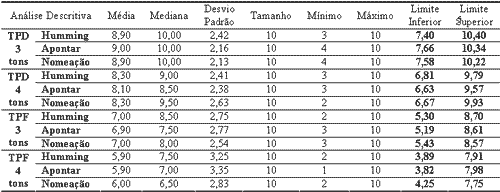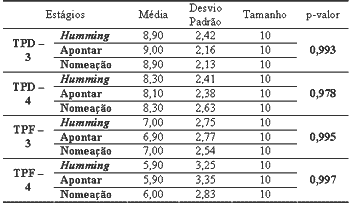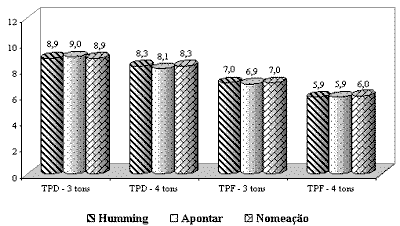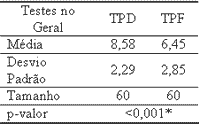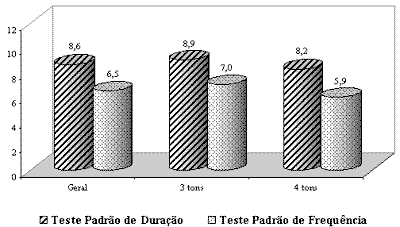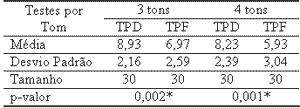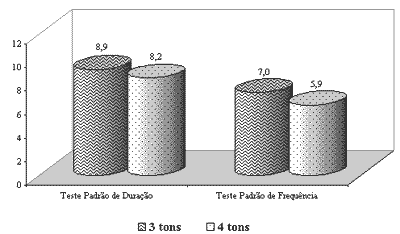

Year: 2004 Vol. 70 Ed. 4 - (14º)
Artigo Original
Pages: 534 to 539
Auditory processing evaluation using nonverbal sounds in subjects with Parkinson's disease
Author(s):
Eliana S. Miranda1,
Liliane D. Pereira2,
Silvana Bommarito3,
Tarcimara M. Silva4
Keywords: Key words: auditory tests, auditory perception, Parkinson's disease.
Abstract:
Introduction: Auditory processing, as we understand, refers to how the individual handles with auditory information. The importance of auditory perception of sound sequences and temporal patterns in acquiring and comprehending symbolic components of language is well recognized. Acoustic properties of speech may be limited to the basic components of duration and frequency analysis. Speech signals are the most important events we receive through hearing and, as we know, speech patterns may be compromised in Parkinson's disease. Objective: To evaluate the performance of subjects diagnosed with Parkinson's disease in Duration and Frequency Pattern Tests. Method: Nonverbal stimuli identification was evaluated in three different modes of response: humming, verbal labeling and indicating. Stimuli were characterized by sequences of three or four elements, varying in duration and frequency. Results: No significant difference was observed considering mode of response; better results were obtained for three-element sequences than four-element sequences and for duration patterns in comparison to frequency patterns. Subjects with Parkinsons's disease demonstrated poorer performance than normal subjects. Conclusion: Temporal ordering is a very important function of the central auditory nervous system. This ability enables the listener to discriminate sound patterns based on auditory ordering or sequencing. Therefore, our findings are important since they stimulate further studies concerning analysis and interpretation processes in patients with Parkinson's disease.
![]()
INTRODUCTION
Speech auditory processing is understood as the skill people have to perceive and interpret speech sound models. This skill involves different stages: detection, sensation, discrimination, location, recognition, understanding, attention and memory 1, 2.
When the field of neurofunctional activities that start with detection of stimulus (cochlea) and finishes with linguistic analysis of information are in full operation, it is possible to reach good communication performance. Any defects in this quick and complex pathway can lead to impairment of interpersonal and intrapersonal language relations 2. We understand that auditory processing assessment is a measure of how subjects manage information that is auditorily received.
Auditory memory is a process that allows acquisition, storage and filing of acoustic information to be able to recover it when required. Memory is present in auditory processing. Among the events that we perceive through hearing, speech is the most important one, which can be affected in Parkinson disease.
James Parkinson, in his original description of the disease in 1817, mentioned speech impediment and difficulty to understand in patients affected by agitating paralysis.
Parkinson disease (PD) is a degenerative disease of central nervous system characterized by the symptomatic triad of tremor at rest, muscle rigidity and bradykinesia 3. Its main cause is lack of dopamine, a neurotransmitter synthesized by the brainstem (substantia nigra) 4.
Insidious, this disease leads to biological, psychological and social changes. Among them, we can include concentration, learning, memory and understanding difficulties, in addition to the fact that patients have vocal, speech, articulation and swallowing deficits, which may lead to considerable difficulties to communicate and eat. Dementia associated with PD is characterized by cognitive and motor slowing down, executive dysfunction and impairment of recall mechanism 5.
In many situations, anti-Parkinson drugs may contribute to the production of mental confusion. Levodopa, an effective drug to treat PD, may result in memory disorders and in severe cases, there may be mental confusion and hallucination.
To study the auditory behavior of Parkinson patients, we used Frequency Pattern Tests (TPF) and Duration Pattern Tests (TPD) with musical sounds.
The skills to perform temporal ordering of sound stimuli are undoubtedly one of the most basic and important functions of the central nervous system. Assessment of auditory skills that involve temporal ordering is conducted through behavioral procedures that functionally analyze the central auditory system. This skill allows the listener to make discriminations based on ordering or sequencing of auditory stimuli.
Studies demonstrated the importance of auditory perception of sound sequences and temporal patterns in acquisition and understanding of conceptual or symbolic components of language. The complex of speech acoustic properties can be reduced to the basic components of duration, frequency and intensity 6.
Thus, getting to know these temporal aspects of frequency and duration patterns in subjects with PD will expand out knowledge and help us understand auditory processing in this affection.
Therefore, the present study intended to characterize temporal pattern auditory skills in the identification of sounds using TPF and TPD in subjects with PD considering the variables type of response (pointing, humming or verbalizing) and identification of 3 and 4 stimuli that varied in frequency and duration.
We applied a temporal pattern test using high sound of 1,122Hz as high frequency and low sound of 880Hz as low frequency, in which the subject was instructed to indicate a sequence of 3 sounds (example: H, L, H - L, L, H; etc.). It could be shown by humming or verbal response, such as naming stimuli. The use of humming allowed the subjects to receive and express the response primarily in the right hemisphere (non-linguistic dominant), whereas verbal response would probably require the extensive use of both hemispheres. In the case of frequency patterns, it seems that the right hemisphere recognizes the acoustic contour of the pattern and the left hemisphere converts the pattern into a verbal response. Both hemispheres should interact appropriately for the production of a correct verbal response to the auditory pattern 7.
Still talking about response mode, upon investigating the differences in manual, verbal and humming response, it was observed, except for the latter, that it was an imitation, a need for real temporal ordering of a sequence presented at a single time 8. Verbal responses are more difficult because they involve more complex cognitive processes of attention, description of real order of components, definition of concept that can represent each perceived stimuli and articulation movements of speech to pronounce the selected word.
Therefore, the battery test for auditory tone patterns of intensity, frequency and duration are important for the observation of integrity of both hemispheres and corpus callosum 9. The type of response also provides information that is probably related to location of lesion on the left hemisphere or corpus callosum, such as the case of subjects who can appropriately respond with humming patterns and present abnormal behavior with verbal response.
The nuclei of the lower region of the brainstem are responsible for the analysis of intensity, frequency and duration of auditory stimuli and upper nuclei of auditory pathways are responsible especially for mean and synthesis of information into a signal that can be used by the brain 10, 11.
The tests for frequency and duration pattern identification allow detection of cortical and inter-hemispheric problems. To be able to codify frequency patterns and duration patterns it is necessary to have interaction between both hemispheres. Thus, if one of the hemispheres is not working appropriately, the conduction of information through the corpus callosum to the other hemisphere is impaired 12.
Studies recommend the use of TPD and TPF in subjects with and without damage to sound detection skills 13, 14, in order to support the set of procedures that assess functioning of neural pattern for non-verbal sound processing 15.
In Brazil, such tests were organized and applied in young normal hearing subjects and in musicians 16. To prepare the procedure, we selected the musical instrument transversal flute. In TPF we used tone of 440Hz (fundamental C). To TPD we used the same tone (440Hz), modifying only the duration time of stimuli, as long sounds of 161ms and short sounds of 59ms. The time interval of silence between them lasted on average 50ms. Stimuli for each temporal pattern were organized in items of 3 and 4 sequences rearranged in 10 items each. The performance of musicians (about 99% of hits) in TPF was statistically significant better when compared to non-musicians (about 60% hits). The performance of musicians in TPD was similar to that of non-musicians (about 97%).
MATERIAL AND METHOD
The present study comprised 10 subjects, 8 male and 2 female, aged 50 to 70 years, diagnosed as having PD, maximum stage III of the disease, according to Hoehn and Yahr score (1967).
We assessed minimum thresholds for modulated pure tone frequency (Warble), testing sound frequencies of 500, 1000, 2000 and 4000 Hz, using Pediatric Audiometer model PA2 by INTERCOUSTICS. Stimuli were presented to each patient in decreasing intensities 20cm from the pinna. TPF and TPD were applied in quiet using sound equipment brand Sharp, in free field, maximum output of stimulus of 80dB HL.
To apply the test, we used a CD with musical tones presented as 3 or 4 consecutive tones for the frequency test (low tone of 440Hz and high tone of 492 Hz), such as for example high tone (H), low tone (L), high tone (H), low tone (L), in 10 presentations of different combinations. The same was done for TPD in which we presented short (S) - 59ms and long (L) (161ms) tones. The tests were applied to each participant whose auditory sensitivity was classified as normal or with hearing loss that did not exceed the level of 60dB HL.
We investigated the differences between manual, verbal and humming responses. To that end, patients were asked to recognize stimuli by responding by pointing to pictures, recognizing the stimuli verbally and recognizing the stimuli by characterizing an imitation pattern (humming).
To analyze the results, we defined the criteria for performance, as follows: in a sequence of 10 separated tones, subjects that had 5 or more correct responses in the sequence of tones were classified as having satisfactory performance. Subjects that had 4 or fewer correct responses in the presented sequence were classified as having dissatisfactory performance.
Concerning statistical analysis, we used the technique to Compare Univariate Means (ANOVA) - parametric technique to compare means. The result of each comparison had a statistical value named p-value. The statistical analysis helped us to draw the conclusions. We defined significance level of 0.05 (5%). In addition to ANOVA, we used a descriptive analysis technique - Confidence Interval - to check how much the mean could vary within a specific confidence likelihood.
RESULTS
Find next the results obtained with the present study.
DISCUSSION
According to the Performance Criteria adopted by the present study, we could observe that in TPD with 3 tones, 90% of the sample had satisfactory performance. The same result was found in the test with 4 tones. In TPF with 3 tones, 70% of the sample had satisfactory result, 20% had dissatisfactory result and 10% had satisfactory result in the humming response and dissatisfactory result in pointing and naming. In TPF with 4 tones, we observed that 60% of the sample had satisfactory result, 30% had dissatisfactory performance, and 10% had satisfactory performance in naming and dissatisfactory response in humming and pointing.
Upon analyzing the p value of the lower and upper limits (Table 1), we observed that 95% of the assessed population showed recognition of TPD greater than 74% to the 3-tone pattern and 66% to 4-tone pattern, which indicated satisfactory performance. To TPF, we observed recognition close to 50% both for 3 tones and 4 tones.
As provided by Table 2 and Figure 1, we observed homogeneity of identification of TPF and TPD in different response modes. Thus, we concluded that there was no statistically significant difference in mode of response.
These findings are in agreement with other studies 8, 9, 15 that investigated differences between manual, verbal and humming response modes and did not detect any differences among the response modes.
In Table 3 and Figure 2, we can comparatively observe results of performance in subjects of the sample, showing different performances concerning duration and frequency and the fact that the performance was better in the aspect of duration.
Corazza15 proposed in his study cut-off reference of 73% or more correct responses for normal subjects in TPF, and 83% or more correct responses for TPD. In the study conducted by Taborga16, data obtained for musicians and non-musicians were worse for TPF and better for TPD when compared to the studies conducted by Corazza15, reaching 58.88% correct responses for TPF and 96.66% for TPD. It was also noticed that subjects in the sample reported that during TPD the concept of long and short and the time parameter concerning duration were easier to be perceived; normally people know the meaning of both concepts as duration cues owing to their own live experiences, as opposed to high and low in TPF. During the collection of these data, the number of correct responses for TPD was greater than for TPF. Such results confirmed the report by Musiek17, who obtained a higher number of correct responses in normal subjects, given that 90% of them presented an index of correct responses of 78% or more. We may conclude that it is an easy test to understand and respond to.
Zanoni18 observed that when it comes to the elderly, recognition of TPD was better than that of TPF.
We believe that the performance observed in subjects with PD in TPF and TPD can be influenced by other aspects such as environmental factors and age range, in addition to evolution of the disease. Thus, we suggest that more studies be conducted in this area to expand our knowledge, improving diagnosis of changes to hearing information processing.
In the studies by Castro11, in which they applied TPD to aphasic and dysarthric subjects, responses to the test were abnormal, concluding that these subjects presented difficulties in sound temporal ordering. The studied subjects, especially the dysarthric ones, presented prosodic abnormalities (speech melody) and monotonous speech, without variations of rhythm and frequency required for good oral production. These alterations are normally caused by central damage to speech motor system.
Upon observing Table 4 and Figure 3 we could conclude that subjects presented better performance in the sequence of 3 tones, as opposed to the sequence of 4 tones in both temporal tests.
Taborga16 in his studies considered TPF and TPD, both with 3 and 4 tones, and responses in the groups of musicians and non-musicians, and observed that in the group of non-musicians, comprising 18 subjects, 3-tone TPF presented nearly 40% correct responses, such as minimum value in 1 subject; only in 2 subjects they reached 100% recognition in this sub-test. In the same test with 4 tones difficulties were greater, with minimum value of recognition of 40% in 5 assessed subjects, and maximum value of 100% hits in only 1 subject. In 3-tone TPD, there was better reception, being that the minimum value was 80% of recognition for 1 subject, 90% for 2 subjects, and 15 subjects recognized the 3-tone sequence with 100% correct responses. In the same test with 4 tones, the author found 10 subjects with 100% correct responses and 8 subjects got only 90% correct.
It is important to emphasize that the small sample size in the present paper did not allow statistical confirmation comparing to Taborga 16 results for TPF and TPD for 3 and 4 tones. The studied population showed difficulties to identify the sequences of 3 and 4 tones in TPF and TPD when compared to the population of adults. Studies with larger samples, including subjects with more defined and localized lesions, can further explain the correlation between test and specific brain damage, such as PD.
CONCLUSION
Upon analyzing the performance of subjects with PD in TPD and TPF, we concluded that:
1. There was no statistically significant difference in performance between different response modes (humming, pointing and naming);
2. There were statistically significant differences between mean values of correct responses for TPD and TPF. The mean value of correct responses for TPD was greater than that for TPF in the studied population.
3. The performance in 3-tone sequence test was more satisfactory than in the 4-tone sequence test.
4. The mean value of correct responses in the temporal pattern test using variation of stimuli concerning sound frequency was 50% both for 3 tones and for 4 tones, and using stimuli variation concerning sound duration was 74% for 3 tones and 66% for 4 tones.
5. Most of the subjects presented worse performance in temporal processing tests compared to subjects without evidence of hearing disorders.
REFERENCES
1. Andrade LAF, Barbosa ER, Cardoso F, Teive HAG. Doença de Parkinson: Estratégias atuais de tratamento. São Paulo: Lemos Editorial; 1999.
2. Arnst DJ. Presbiacusia. In: Katz J. Tratado de audiologia clínica. São Paulo: Manole; 1989.
3. Boothroyd A. The sense of hearing. In: Speech, Acoustic and Perception Disorders. Austin: Pro-Ed Studies in Communicative Disorders; 1986.
4. Castro LCD. Avaliação do Processamento Auditivo Central em indivíduos com lesão cerebral: Teste de Padrão de Duração. São Paulo, 2001 - Tese de Mestrado - Universidade Federal de São Paulo.
5. Corazza MC. Avaliação do processamento auditivo central em adultos: teste de padrões tonais auditivos de freqüência e teste de padrões tonais auditivos de duração. São Paulo, 1998 - Tese de Doutorado - Universidade Federal de São Paulo.
6. Ferraz HB, Aguiar PMC. Parkinsonismo: atualização terapêutica. São Paulo: Editora Artes Médicas; 2001.
7. Limongi JCP. Conhecendo melhor a doença de Parkinson. Uma abordagem multidisciplinar com orientações práticas para o dia-a-dia. São Paulo: Plexus; 2001.
8. Musiek FE. Aplicação de testes auditivos centrais - Uma abordagem geral. In: Tratado de Audiologia Clínica. São Paulo: Manole; 1989.
9. Musiek FE. Frequency (pitch) and duration pattern tests. J Am Acad Audiology 1994; 5: 265-8.
10. Musiek FE, Lamb L. Central auditory assessment: an overview. In: Katz J. Handbook of clinical audiology. 4th ed. Baltimore: Williams, Wilkins; 1994. cap.14.
11. Pereira LD. Processamento auditivo central: abordagem passo a passo. In: Pereira LD, Schochat E. Processamento auditivo - manual de avaliação. São Paulo: Ed. Lovise; 1997.
12. Pinheiro ML. Tests of central auditory function in children with learning disabilities. In: Keith RW ed, Central auditory dysfunction. New York: Grune, Stratton; 1977.
13. Pinheiro ML, Tinta T. Differences among response mode in pitch pattern perception. In: Andrews JR, Burns MS. Selected papers in language and phonology. Evanston, I.L: Institute for Continuing Professional Education, vol. 2, 1977.
14. Ptacek PH, Pinheiro M. Pattern reversal in auditory perception. J Acoust Soc Am 1971; 49 (suppl 2):493-8.
15. Russo ICP, Santos TMM. A prática da audiologia clinica. São Paulo: Cortez; 1993.
16. Taborga MBL. Processos Temporais Auditivos em Músicos de Petrópolis. [Monografia apresentada no Curso de Especialização da Universidade Federal de São Paulo e Universidade Católica de Petrópolis]. Rio de Janeiro, 1999.
17. Wilde L, Katz J. Distúrbios da percepção auditiva em crianças. In: Katz J. Tratado de audiologia clínica. São Paulo: Manole; 1989.
18. Zanoni LG. Processamento Auditivo Central em idosos: teste de Padrão de Freqüência e de Duração. Monografia apresentada no Curso de Especialização da Universidade Federal de São Paulo. São Paulo, 1999.
Table 1. Descriptive measures of correct responses given by subjects by procedure used.Table 2. Comparison of different types of responses (humming, pointing and naming) in each of the tests in the studied sample.
Figure 1. Chart of the comparison of types of responses (Humming, Pointing and Naming) as provided by results in Table 2.Table 3. Descriptive measures of correct responses obtained in Duration and Frequency Pattern tests in the studied sample and statistical values (p-value) to compare their performance.
Figure 2. Chart of the comparison between Duration and Pattern Standard Tests as provided by results in Table 3.Table 4. Descriptive measures of correct responses for three and four tones in Duration and Frequency Standard Tests in the studied population and statistical values (p-value) to compare aspects of Frequency and Duration.
Figure 3. Chart of the comparison of performance with three and four tones as provided by results in Table 4.
